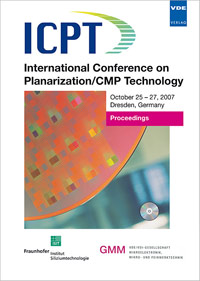Greenwood-Williamson Model for Pattern-Dependent Planarization
Conference: ICPT 2007 - International Conference on Planarization / CMP Technology
10/25/2007 - 10/27/2007 at Dresden, Germany
Proceedings: ICPT 2007
Pages: 6Language: englishTyp: PDF
Personal VDE Members are entitled to a 10% discount on this title
Authors:
Rzehak, Roland; Vasilev, Boris (Qimonda Dresden GmbH & Co.OHG, Königsbrücker Str. 180, 01099 Dresden, Germany)
Abstract:
Prediction of the chip-scale non-uniformity remaining after CMP has long been based on the density-stepheight model. Within this model, the mechanics of contact between the wafer and the polishing pad is described in a highly simplified manner by taking the pad as a collection of springs with a certain length and stiffness. More recently there has been a quest in CMP modeling to improve the model accuracy and increase its predictive capabilities by considering a more refined description of pad wafer contact including physical effects beyond mere pad elasticity. Continuing these efforts we here present a model for the effects of pattern density in STI-CMP which accounts for the roughness of the polishing pad's surface. To this end a Greenwood-Williamson description of contact between pad and wafer is used. For the special case of an exponential asperity height distribution, analytical expressions for the UP and DOWN removal rates are derived. These contain the contact and non-contact regimes of the standard model as limiting cases where the stepheight is either much smaller or much larger than a length-scale related to the pad-roughness. Thus the present model may be viewed as an extension of the density-stepheight model. Both the standard and the extended model are compared to polishing data with emphasis on dishing in the overpolish regime.


